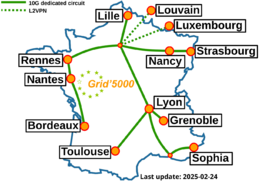Grid5000:Home: Difference between revisions
No edit summary |
Lpouilloux (talk | contribs) No edit summary |
||
| Line 39: | Line 39: | ||
==Latest news== | ==Latest news== | ||
<rss max=4 item-max-length="2000">https://www.grid5000.fr/ | <rss max=4 item-max-length="2000">https://www.grid5000.fr/rss/G5KNews.php</rss> | ||
---- | ---- | ||
[[News|Read more news]] | [[News|Read more news]] | ||
Revision as of 09:29, 26 October 2023
|
Grid'5000 is a large-scale and flexible testbed for experiment-driven research in all areas of computer science, with a focus on parallel and distributed computing including Cloud, HPC and Big Data and AI. Key features:
Grid'5000 is merging with FIT to build the SILECS Infrastructure for Large-scale Experimental Computer Science. Read an Introduction to SILECS (April 2018)
Older documents:
|
Random pick of publications
Five random publications that benefited from Grid'5000 (at least 2925 overall):
- Clément Courageux-Sudan, Anne-Cécile Orgerie, Martin Quinson. Studying the end-to-end performance, energy consumption and carbon footprint of fog applications. ISCC 2024 - 29th IEEE Symposium on Computers and Communications, Jun 2024, Paris, France. pp.1-7. hal-04581677 view on HAL pdf
- Houssam Elbouanani, Chadi Barakat, Walid Dabbous, Thierry Turletti. Troubleshooting Distributed Network Emulation. Annals of Telecommunications - annales des télécommunications, 2024, 79 (April), pp.227-239. 10.1007/s12243-024-01010-y. hal-04373896 view on HAL pdf
- Barbara Gendron, Gaël Guibon. Context-Aware Siamese Networks for Efficient Emotion Recognition in Conversation. 2024. hal-04532408 view on HAL pdf
- Igor Fontana de Nardin. Ordonnancement en ligne de tâches IT et engagement de sources dans un centre de calcul alimenté par des énergies renouvelables. Réseaux et télécommunications cs.NI. Institut National Polytechnique de Toulouse - INPT, 2023. Français. NNT : 2023INPT0104. tel-04361471 view on HAL pdf
- Dorian Goepp, Fernando Ayats Llamas, Olivier Richard, Quentin Guilloteau. ACM REP24 Tutorial: Reproducible distributed environments with NixOS Compose. 2024, pp.1-3. hal-04613983 view on HAL pdf
Latest news
![]() Some changes on the hardware configuration of Grenoble nodes
Some changes on the hardware configuration of Grenoble nodes
We recently did somes hardware changes on clusters yeti, troll and dahu.
The changes are as follows:
- yeti-[1,3]: 1× NVMe
- yeti-[2,4]: 2× NVMe
oarsub request. For example:oarsub -I -p "dahu and opa_count > 0"
-- Grid'5000 Team 14:50, 24 November 2025 (CEST)
![]() Cluster "clervaux" is now in the default queue in Luxembourg
Cluster "clervaux" is now in the default queue in Luxembourg
We are pleased to announce that the clervaux[1] cluster of Luxembourg is now available in the default queue.
Clervaux is a cluster composed of 48 CPU nodes.
Each node features:
This cluster was funded by the University of Luxembourg.
[1] https://www.grid5000.fr/w/Luxembourg:Hardware#clervaux
-- Grid'5000 Team 10:50, 21 October 2025 (CEST)
![]() Tutorials of the SLICES-FR school 2025
Tutorials of the SLICES-FR school 2025
The tutorial of the first SLICES-FR School, which was held from July 7th to 11th in Lyon are available on the following pages:
-- Grid'5000 Team 15:19, 1 October 2025 (CEST)
![]() End of support for Debian10 environments
End of support for Debian10 environments
Support for the debian10/buster kadeploy environments is stopped due to the end of upstream support and compatibility issues with recent hardware.
The last version of the debian10 environments (version 2025082716) will remain available on /grid5000. Older versions can still be accessed in the archive directory (see /grid5000/README.unmaintained-envs for more information).
-- Grid'5000 Team 09:21, 1 October 2025 (CEST)
Grid'5000 sites
Current funding
As from June 2008, Inria is the main contributor to Grid'5000 funding.
INRIA |
CNRS |
UniversitiesIMT Atlantique |
Regional councilsAquitaine |


